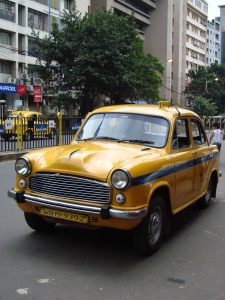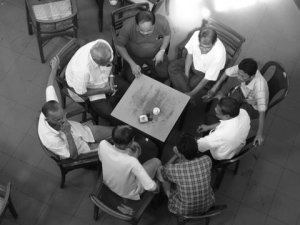If in Assam people are used to a lahe-lahe (slowly) culture, then West Bengal seems to run at an even more leisurely pace. Calcutta, which served as the capital of the British East India Company, felt like a city stuck in the 60s, resistant to change. For one, Ambassadors are the only taxis that are allowed to roam the streets – mainly because the Hindustan Motors plant that manufactures these cars is located in the state. Rickshaws pulled manually are still a common mode of transport around the city. The city’s tram line is the only one of its kind in India and apart from a few modern carriages that have been recently introduced, most look like they haven’t been replaced since the British left. However, one aspect of urban transportation that the city has been ahead of others is in the Metro system. We took a ride and found it very clean and punctual. The platform even had cable TV showing the latest EPL highlights.

The Ambassador Taxi in Calcutta

Rickshaw puller

The Calcutta Tram
Jute, a very lucrative cash crop and abundantly grown in Bengal, is one of the state’s largest exports. We visited the Howrah jute mill, which was set up during the British time and subsequently purchased by a Marwari businessman. The mill was large, producing 130 tons of jute every day and employing hundreds of workers. However, the machines and processes being used seemed ancient, as if no changes had taken place in the last 6 decades. Dust and dirt filled the air around us and the environment seemed to come across as a health hazard for the workers.

Jute Mill
Every big city has its own colonial imprint – for Calcutta, this is the Victoria Memorial Hall (the most popular tourist attraction, after the food that is). This lavish monument comes across as a mix between St. Paul’s Cathedral in London and the Taj Mahal. Inside, there is an excellent collection of historical photographs and paintings depicting times gone by. There is also a well preserved exhibition hall (air-conditioned) with timelines, artifacts and even a showcase portraying village life.

Victoria Memorial Hall
Aside from visiting a couple of colleges, Presidency and Jadavpur, we stopped by the well-renowned Indian Coffee House. This is the place where the quintessential Bengali comes to debate and discuss anything from the weather to cricket to politics, over a cup of coffee. A very simplistic milieu where even bottled water is not available, this is where the philosophy of Marx and Lenin find their most vocal support.

Indian Coffee House
Change (in governance) in West Bengal could well be around the corner. A number of individuals whom we spoke to mentioned the rising tide and influence of Mamata Banerjee and her Trinamool Congress party. If victorious in the next election, it would be the first time a party other than the CPM would be in power over the last 3 decades. Maybe this is a sign of things to come.




Leave a comment